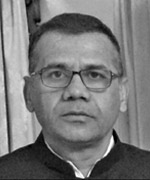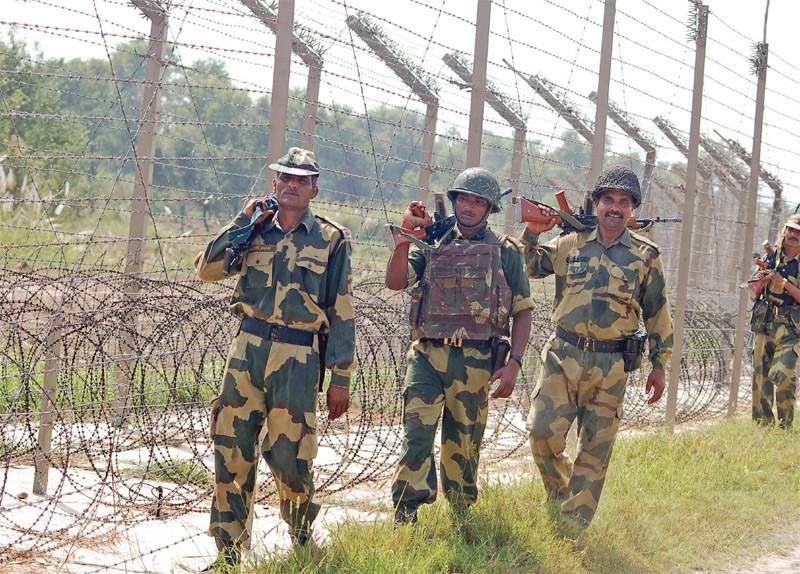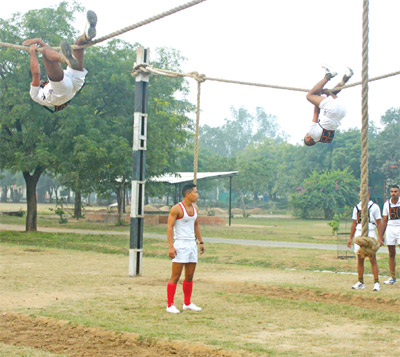Career stagnation, poor housing, lack of modernisation plague paramilitary forces
 R.C. Sharma
R.C. Sharma
Other than the Border Security Force (BSF), Indo-Tibetan Border Police (ITBP) and the Sashatra Seema Bal (SSB), all border-guarding forces, the Central Armed Police Forces (CAPFs) comprise the National Security Guard (NSG), the Central Reserve Police Force (CRPF) and the Central Industrial Security Force (CISF).
The CISF provides security to airports, government offices and industrial establishments. With a strength of more than a million, the CAPFs are an integral part of the internal security component. In addition to their primary role, they perform multifarious tasks assigned by the government. The border guarding forces have wartime role too, which they perform under the operational control of the army.
CAPF personnel work round the clock, 365 days of the year. Problems and issues affecting the CAPFs and CAPF personnel affect organisational efficiency. They need attention and addressing on a priority. The CAPFs have huge vacancies which need filling on a priority. In response to a starred question by Anil Agrawal in the Rajya Sabha concerning the strength of the seven CAPFs, minister of state for home Nityanand Rai stated that while the sanctioned strength of CAPFs was 10,05,779, there were 84,405 vacancies. The officer cadre in the CAPFs is just one to two per cent of the total strength, meaning that about 99 per cent strength comprises jawans and subordinate officers. Therefore, there is an urgent need for a robust organisational set-up for efficient administration. Personnel-friendly human resource policies, housing satisfaction and welfare with effective grievance redressal mechanisms are needed to foster camaraderie and raise morale and motivation. An affirmative set-up will help bring down attrition owing to voluntary retirements/ resignations, suicides and fratricides. Personnel need care and compassion to make the CAPF security apparatus stronger and robust to meet dynamic security challenges facing the country.
The 242nd report of the department-related parliamentary standing committee on home affairs, demand for grants (2023-24), was presented to the Rajya Sabha on March 17, 2023. The parliamentary standing committee noted that in 2018-2022, 654 CAPF personnel had committed suicide in the last five years. The highest suicide rate was in the CRPF followed by the BSF. As for attrition, the standing committee said 50,155 CAPF personnel had resigned in the last five years with the highest attrition rate in the BSF followed by the CRPF.

The budget for modernisation plan IV of the CAPFs was Rs 248.30 crore at the budget estimate stage for 2022-23 but this was reduced to Rs 154.40 crore at revised estimate stage. The seven CAPFs could spend only Rs 22.16 crore for modernisation in 2022-23 and the percentage expenditure was just 14.35 per cent with respect to the revised estimate. Since the CAPFs were unable to utilise the modernisation budget, it was reduced to Rs 202.47 crore in 2023-24. The purpose of modernisation is procurement of modern weapons, vehicles, communication system, bulletproof vehicles, MPVs and clothing. There was low expenditure under the modernisation plan III too. The committee wondered why the CAPFs did not spend much on modernisation despite their requests for the purpose. The reason seems administrative hebetude. There is a need for a monitoring mechanism for proper and optimum utilisation of the modernisation budget.
The standing committee was informed that CAPF officers were not sent to foreign countries for mid-career training programme (MCTP). It noted that CAPF officers must receive training in foreign countries as part of their career training programme. The committee said due to an increase in deployment, jawans were not available for training. Housing satisfaction levels were only 47.95 per cent, the committee found. In border guarding forces it was even lower, at 42.89 per cent. There is a need to carry out a qualitative analysis of housing satisfaction levels in addition to quantity surveys. Proper utilisation of the modernisation budget and enhanced housing satisfaction improves the satisfaction index and helps in checking attrition.
Infrastructure upgrade is a continuous process to keep pace with the dynamic security challenges. But there is deceleration in infrastructure upgrade in terms of modernisation. Personnel-friendly human resource policies reinforce trust and faith of the rank and file in the leadership. The current human resource policies have not ensured timely promotions and financial benefits. On 28 March 2022, news portal News 18 highlighted acute stagnation in the CAPFs saying the home ministry had sought ‘practical suggestions from paramilitary forces.’

It takes about 18-22 years to be promoted from constable to head constable, 28-33 years to become an assistant sub-inspector and about 38-39 years to pick up the rank of a sub-inspector. The direct entry sub-inspectors in some of the CAPFs are still inspectors even after putting in about 18-19 years of service. Among officers, an assistant commandant picks up the rank of a deputy commandant after 12-13 years. The lack of empathy and affirmative human resource management is one of the major causes of attrition and a major drawback in CAPF management.
The government recognises the harsh and difficult service conditions in the CAPFs but it seems to lacks realistic inputs to address the issues. In order to bring about qualitative changes, the most important thing is to accept in the policy realm that CAPFs are armed forces, not civil services. Civil norms of modified assured career progression (MACP) must not be applied to the CAPFs. There is no justifiable comparison between men working in the
ministry/office in metropolitan cities and CAPF personnel deployed in unsettled borders, LWE areas or foreign countries. Treating both as equals is like comparing apples and oranges, which is impractical and unrealistic. For the CAPFs, sanction MACP as per residency period of rank and not after 10/20/30 years of service. All these measures fall in the domain and authority of the ministry of home affairs (MHA) and are easily implementable by it.
There are also ways and means to improve the service condition of CAPF personnel, raise morale and check attrition. But there appears to be a lack of determination to carry out reforms. As stagnation is a major cause for attrition, the solution lies in reforming the rank structure. It is time to restore the rank of lance naik and naik to enable a constable to earn three promotions in the first 10-12 years of service. Do not shelve the implementation of innovative reforms citing expenditure. This single revolutionary reform will bolster command hierarchy, help maintain a young age profile and enhance professionalism. There is a need to abolish the rank of ASI and designate a head constable as a section commander. ASIs are generally of an advanced age who are unable to lead men effectively. The restoration of the rank of lance naik and naik will ensure a young age profile and rejuvenate the CAPFs.
In 2019, the government raised the retirement age in the CAPFs from 57 to 60 years. It was to undo an administrative anomaly of having two age groups and bring uniformity in the retirement age. It not only worsened
the stagnation but adversely affected the physical and mental profile, creating enormous problems for commanders in man management. There is a need to bring down the retirement age to 55 years to maintain a young age profile since the nature of duties is difficult to say the least. Along with it, have one retirement age for all, including support cadres like medical, whose retirement age is 65 years. For better synergy, cooperation and coordination treat all cadres equally for financial upgradation and promotions. Introduce lateral induction into the police and reserve at least 10 per cent quota for lateral induction of all ranks in state police forces. It will help in maintaining a young age profile of the CAPFs, check stagnation and provide professional manpower to the police.

In addition to the above measures, the existing grievance redressal mechanisms need strengthening. The convention and practice of interviews through formal and informal interactions at all levels need institutionalisation. The interview before, after leave, before and after course and Sainik Sammelans have to be realistic to know the well-being of the men, their performance and to address genuine grievances. Commanders need to be fair and impartial in conduct and not indulge in favouritism based on caste, creed, region and religion and desist from abusive, insulting and humiliating behaviour. Commanders need to monitor the physical and mental well-being of his men through regular informal interactions and counselling sessions. There should be special emphasis on timely leave, proper accommodation, medical facilities and timely disbursal of monetary allowances. The inability to address these problems and a delay in redressal of issues contribute to the stress and attrition among personnel. There should be a realistic timeline to address grievances and accountability must be fixed for delay in redressal. There should also be accountability for delays in modernisation and infrastructure development leading to the allotted budget remaining unutilised.
There has to be zero tolerance for indiscipline, corruption and for conduct unbecoming of a soldier in all ranks. Commanders must always remember, the words of Field Marshall Philip Chetwode, famous as Chetwode motto: ‘The safety, honour and welfare of your country come first, always and every time. The honour, welfare and comfort of the men you command come next. Your own ease, comfort and safety come last, always and every time.’
The CAPF personnel fall under two authorities, the MHA, the administrative ministry, and the command hierarchy of the respective CAPFs. Both need to carry out an in-depth analysis of problems of the CAPFs and have empathy for the CAPF personnel. Unless both function in coordination to address various issues, grievances will persist, affecting organisational efficiency. A piecemeal or situational approach must be avoided as it only prolongs deficiencies, affecting efficiency.

